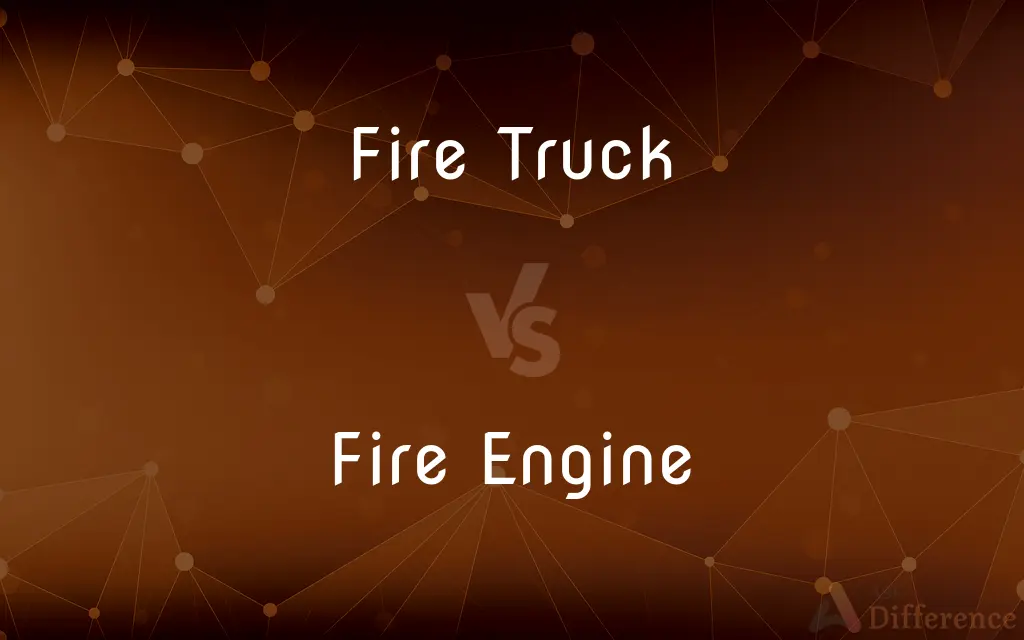Fire Truck vs. Fire Engine — What's the Difference?
By Maham Liaqat & Fiza Rafique — Published on November 5, 2024
A fire engine is equipped for firefighting with water, hose, and pump, focusing on extinguishing fires, whereas a fire truck carries ladders, rescue tools, and may not have a pump or water tank, aimed at support and rescue.

Difference Between Fire Truck and Fire Engine
Table of Contents
ADVERTISEMENT
Key Differences
A fire engine, often referred to as a pumper, is primarily designed for fire suppression. It carries water, hoses, and has a built-in pump that allows firefighters to spray water directly onto a fire. This equipment is essential for the initial attack on fires, aiming to extinguish them quickly. On the other hand, a fire truck, sometimes called a ladder truck, is equipped with large ladders, including aerial ladders, which can be extended to reach high places. It also carries various tools for search and rescue, ventilation, and forcible entry, but it may not have the capability to pump water.
While the fire engine is at the core of firefighting operations with its water-carrying capacity, hoses, and pumps, enabling firefighters to tackle the blaze directly, the fire truck plays a crucial supporting role. The fire truck's equipment, such as ground ladders, rescue ropes, and specialized tools like the Jaws of Life, are used in different scenarios ranging from rescuing individuals from high floors to cutting through obstacles during a rescue operation. This distinction highlights the complementary functions of both vehicles at a fire scene.
In terms of deployment, fire engines are usually the first to be dispatched to a fire incident because of their essential firefighting capabilities. They are equipped to start combating the fire immediately upon arrival. Fire trucks, while also often present at significant incidents, are dispatched when there is a specific need for their specialized equipment and capabilities, such as when there are people to be rescued from heights or when there is a complex extrication situation.
The personnel on a fire engine are trained primarily in fire suppression techniques, including operating the pump and managing water supply lines. In contrast, firefighters on a fire truck are skilled in technical rescue operations, including using the aerial ladder and performing complex rescues. This specialization in training and equipment ensures that both vehicles are optimally used according to the demands of the emergency.
The presence of both a fire engine and a fire truck at a scene provides a comprehensive response to various emergencies, from extinguishing fires to performing rescues. The fire engine focuses on putting out the fire, while the fire truck supports these efforts with its array of tools and equipment designed for saving lives and property, illustrating the symbiotic relationship between these two critical firefighting apparatus.
ADVERTISEMENT
Comparison Chart
Primary Function
Fire suppression
Rescue and support
Equipment
Water tank, hoses, pump
Ladders, rescue tools, may lack pump/water
Role in Firefighting
Directly extinguishes fires
Supports with rescue, access, and ventilation
Deployment
First to arrive for firefighting
Dispatched for specific needs or larger incidents
Personnel Training
Focused on fire suppression
Skilled in technical rescue and ladder operations
Compare with Definitions
Fire Truck
Trained in rescue operations and ladder usage.
The truck crew's training in technical rescue was instrumental in safely extracting victims from the debris.
Fire Engine
Equipped with a pump to distribute water through hoses.
Firefighters from the engine company quickly set up the pump and rolled out hoses to fight the fire.
Fire Truck
Carries tools for rescue, ventilation, and forcible entry.
The crew used the fire truck's tools to ventilate the roof and facilitate smoke clearance.
Fire Engine
A vehicle designed for firefighting, equipped with water, hose, and a pump.
The fire department dispatched a fire engine to the burning building to immediately start extinguishing the flames.
Fire Truck
Provides support in rescues and accessing difficult areas.
Firefighters from the truck company made a rapid entry using the aerial ladder to reach victims.
Fire Engine
Firefighters are trained in fire suppression and pump operation.
The engine crew's expertise in handling complex pump operations was vital in managing the water flow to extinguish the fire.
Fire Truck
Features extendable ladders for high-rise operations.
The fire truck's aerial ladder was crucial in bringing firefighters to the top floors for ventilation.
Fire Engine
Focuses on putting out fires.
Upon arrival, the fire engine's crew immediately began attacking the fire to prevent it from spreading.
Fire Truck
A firefighting vehicle equipped with ladders and rescue tools, but not necessarily water or a pump.
The fire truck arrived with its aerial ladder extended to rescue people trapped on the upper floors.
Fire Engine
Carries its own water supply for firefighting.
The fire engine's large water tank was crucial in providing an initial attack on the fire until a hydrant supply could be established.
Common Curiosities
Can a fire truck fight fires?
While primarily for rescue and support, some fire trucks have water hoses and can assist in firefighting, but they lack the extensive firefighting capabilities of a fire engine.
How do firefighters decide whether to dispatch a fire engine or a fire truck?
The type of emergency dictates the response. Fire engines are dispatched for direct firefighting, while trucks are sent for rescues, aerial access, or when additional tools are needed.
What makes a fire engine different from a regular truck?
A fire engine is specifically designed and equipped for firefighting, with water, hoses, and a pump, unlike regular trucks.
Why doesn't every fire truck have a pump?
Fire trucks are designed for specialized tasks like rescue and ventilation. Not all models are equipped with pumps, which are primarily for fire suppression.
Is it more expensive to maintain a fire engine or a fire truck?
Costs can vary based on the specific equipment and frequency of use, but both types of vehicles require significant investment in maintenance and training.
Can fire trucks carry water?
Some fire trucks may carry a small amount of water and a pump, but their primary function is not firefighting.
Are fire engine and fire truck personnel trained differently?
Yes, engine personnel are trained in fire suppression, while truck personnel are skilled in rescue, ladder operations, and using specialized tools.
How often do fire engines and trucks get replaced?
Replacement depends on the department's budget, the vehicle's condition, and technological advancements, typically every 10-15 years.
Can fire trucks perform rescues without a fire engine present?
Yes, fire trucks can perform certain rescues and tasks independently, but they work best alongside engines in emergencies.
What's the main reason for having both a fire engine and a fire truck respond to an emergency?
Having both ensures a comprehensive response, combining firefighting capabilities with rescue and specialized support functions.
Share Your Discovery

Previous Comparison
Slavic Facial Features vs. Germanic Facial Features
Next Comparison
Vultures vs. BuzzardsAuthor Spotlight
Written by
Maham LiaqatCo-written by
Fiza RafiqueFiza Rafique is a skilled content writer at AskDifference.com, where she meticulously refines and enhances written pieces. Drawing from her vast editorial expertise, Fiza ensures clarity, accuracy, and precision in every article. Passionate about language, she continually seeks to elevate the quality of content for readers worldwide.














































